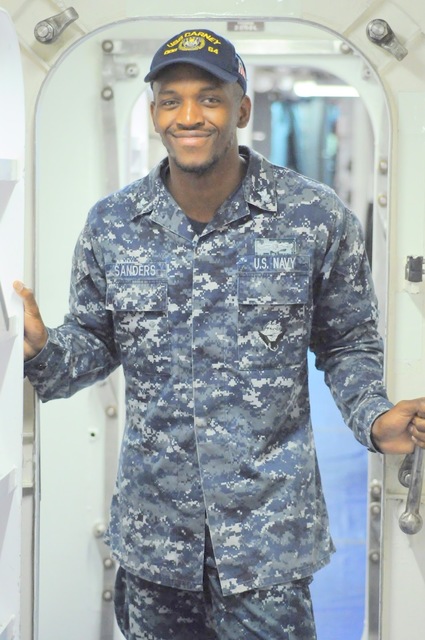ROTA, Spain – A 2010 Terry Sanford High School graduate and St. Pauls, N.C., native is serving in the U.S. Navy aboard the guided missile destroyer, USS Carney.
Petty Officer 2nd Class Diamond Sanders is a cryptologic technician (collection) aboard the forward-deployed Arleigh Burke-class guided missile destroyer operating out of Rota, Spain. Carney is one of four destroyers home ported in Rota.
A Navy cryptologic technician listens to radio signals to collect information about enemy activity.
“It’s unique work and not for everyone,” said Sanders. “It’s very technical and intense.”
Commissioned in June 1996, the Arleigh Burke-class guided-missile destroyer, Carney, measures approximately 500 feet and is powered by four gas turbines that allow the destroyer to achieve over 30 mph in open seas. It was named in honor of former Chief of Naval Operations Adm. Robert Carney.
This ship has been fitted with the Aegis ballistic missile defense (BMD) capability that enables the ship to conduct long-range surveillance, tracking, and engagement of short and medium-range ballistic missiles.
According to Navy officials, destroyers are tactical multi-mission surface combatants capable of conducting anti-air warfare, anti-submarine warfare and anti-surface warfare, as well as humanitarian assistance. Fast, maneuverable, and technically advanced, destroyers provide the required warfighting expertise and operational flexibility to execute any tasking overseas.
Assigned to U.S. 6th Fleet, sailors are on watch throughout the European region and are important assets supporting the European Phased Adaptive Approach to enhance the security of that area of the world from ballistic missile threats originating in the Middle East.
In addition to Carney, three other BMD capable ships are forwarded deployed in Rota: USS Porter, USS Donald Cook and USS Ross. Having four destroyers based in Rota gives the U.S. 6th Fleet flexibility to send these ships to a variety of locations for a range of missions, while at the same time providing a large umbrella of protection for European allies.
Approximately 30 officers and 300 enlisted men and women make up the ship’s company. Their jobs are highly specialized and keep each part of the cruiser running smoothly, according to Navy officials. The jobs range from washing dishes and preparing meals to maintaining engines and handling weaponry.
“This is a good crew,” said Sanders. “We travel together and meet different people. I’ve seen so many interesting places and cultures.”
Challenging living conditions build strong fellowship among the crew, Navy officials explained. The crew is highly motivated, and quickly adapt to changing conditions. It is a busy life of specialized work, watches, and drills.
As a member of one of the U.S. Navy’s most relied upon assets, Sanders explained that he and other Carney sailors know they are part of a legacy that will be last beyond their lifetimes.
“By serving in the Navy, I’m setting an example for my friends and family back home,” added Sanders.
U.S. Navy Lt. Philip Fortnam is affiliated with the Navy Office of Community Outreach Public Affairs.


